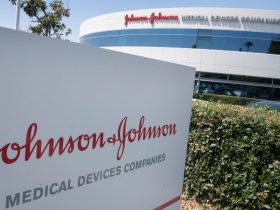Diversified Healthcare Trust (NASDAQ:DHC) Q1 2024 Earnings Call Transcript May 7, 2024 10:00 AM ET
Company Participants
Kevin Brady – Director of Investor Relations
Chris Bilotto – President and Chief Executive Officer
Matthew Brown – Chief Financial Officer
Conference Call Participants
Bryan Maher – B. Riley Securities
Aaron Hecht – Citizens JMP
Operator
Good morning, and welcome to the Diversified Healthcare Trust First Quarter 2024 Earnings Conference Call. All participants will be in listen-only mode. [Operator Instructions] Please note this event is being recorded.
I would now like to turn the call over to Kevin Brady, Director of Investor Relations. Please go ahead.
Kevin Brady
Thanks, Nick. Good morning. Joining me on today’s call are Chris Bilotto, President and Chief Executive Officer; and Matt Brown, Chief Financial Officer and Treasurer. Today’s call includes a presentation by management followed by a question-and-answer session with sell-side analysts. Please note that the recording and retransmission of today’s conference call is prohibited without the prior written consent of the company.
Today’s conference call contains forward-looking statements within the meaning of the Private Securities Litigation Reform Act of 1995 and other Security Laws. These forward-looking statements are based upon DHC’s beliefs and expectations as of today, Tuesday, May 7, 2024. The company undertakes no obligation to revise or publicly release the results of any revision to the forward-looking statements made in today’s call other than through filings with the Securities and Exchange Commission or SEC.
In addition, we will be discussing non-GAAP numbers, including normalized funds from operations or normalized FFO, net operating income or NOI, and cash basis net operating income or cash basis NOI. A reconciliation of these non-GAAP figures to net income is available in our financial results package which can be found on our website at www.dhcreit.com. Actual results may differ materially from those projected in any forward-looking statements. Additional information concerning factors that could cause those differences is contained in our filings with the SEC. Investors are cautioned not to place undue reliance upon any forward-looking statements.
And finally, we will be providing guidance on this call, including SHOP net operating income or SHOP NOI. We are not providing a reconciliation of these non-GAAP measures as part of our guidance because certain information required for such reconciliation is not available without unreasonable efforts or at all, such as gains and losses or impairment charges related to the disposition of real estate.
With that, I will turn the call over to Chris.
Chris Bilotto
Thank you, Kevin. Good morning, everyone, and thank you for joining our call. Last evening, DHC reported first quarter results that reflect operating and financial improvements across our portfolio. On today’s call, I will provide a high-level overview of DHC’s first quarter financial and operating results along with key strategic initiatives that underpin our guidance. Later, Matt will review first quarter financial results and provide additional detail related to our strategy to strengthen our capital and liquidity profile.
First quarter financial results reflect continued improvement within our SHOP segment, consecutive mark-to-market rent growth within our Medical Office and Life Science segment, along with continued advancement of targeted strategies for financing, capital deployment and operator transitions. General market fundamentals supporting favorable trends for healthcare and senior housing, along with the senior housing construction supply-demand imbalance continue to be a bright spot as we advance through the year.
Relative to the year-ago period, our same property cash basis NOI increased 9.5% as a result of the strong performance within our SHOP segment. We credit our positive performance to several factors, including our community investments, our dedication to operator excellence in this segment and the favorable tailwinds in the healthcare industry. On the financing side, we remain active with our efforts targeting secured financing on select Medical Office, Life Science and SHOP properties to improve liquidity and repay the 2025 debt maturity, which Matt will provide additional details on momentarily.
Turning to our first quarter SHOP performance, strong results are demonstrated by our revenue increase of 10% over the year-ago period supported by a 200 basis point increase in occupancy and a 6.8% increase in total RevPOR. These results reflect consistent improvements across independent living, assisted living and memory care. On a sequential basis, revenue increased 4.7%, primarily driven by rate increases that occurred within the first quarter at our Aleris managed communities along with increases within our level of care. Notably, NOI margin increased 180 basis points and 260 basis points on a year-over-year and sequential quarter basis, respectively.
While we are pleased with our progress, with our performance, we retain an active asset management philosophy to support continued opportunities across our communities. This includes rationalization of further operator changes consistent with the 13 communities we transitioned earlier this year. As a reminder, these transition communities contributed negative EBITDA of $3.2 million during 2023, and for the first quarter, negative EBITDA of $920,000. With the completion of the transition, we expect to see meaningful improvement of operating and financial performance for the back half of the year.
Additionally, we will assess specific dispositions and future acquisitions focusing on densifying our presence in certain markets. With this, we anticipate benefiting from sales and cost synergies as well as providing broader options for residents. With respect to our capital refresh and renovation projects, we are advancing refresh projects in 23 of our SHOP communities that are expected to be completed in Q4. These refresh projects, mostly cosmetic upgrades and FF&E replacement. Estimated costs for these projects are $25.7 million or roughly $6,600 per unit and we are targeting an ROI of 8% to 10% when stabilized.
With respect to major renovations, in the first quarter, we completed the renovation of our community in Arlington Heights, Illinois, totaling $5 million or $17,800 per unit, with additional qualifying renovations underway at two of our communities. Major renovations generally include base-level refresh work along with changes to the acuity mix, amenity enhancements and other potential NOI drivers where we believe a minimum ROI of 15% is achievable upon stabilization. These refresh projects are a continuation of our business plan to improve our communities having completed similar scale renovations at more than 90 communities since 2021. We expect these improvements to better position our communities as a top choice for current and future residents, drive occupancy and contribute to continued NOI growth and margin expansion. As provided with our prior call, our 2024 SHOP full year guidance outlook remains generally unchanged, which Matt will speak to in more detail.
Turning to highlights for the Medical Office, Life Science and Wellness Center portfolio. We ended the first quarter with 102 Medical Office and Life Science assets consisting of 8.5 million square feet with same-store occupancy of 89.8% and a weighted average lease term of 5.5 years. Notably, we leased approximately 101,000 at weighted average rents that were 11.5% higher than prior rents for the same space, which represents the third consecutive quarter of double-digit positive rent roll ups. Within our Wellness Center portfolio, we completed a five-year renewal for three of our wellness centers in Albuquerque, New Mexico, totaling 130,000 square feet, including a 7.5% rent roll up and no leasing capital. As of quarter end, our 10 wellness centers are well covered at 1.67 times with a WALT of 15.9 years.
As discussed on our prior call, we are proactively working through opportunities supporting current vacancies along with our known vacates. The change in occupancy from the fourth quarter was primarily driven by known vacates with two tenants totaling 225,000 square feet and located in Kansas City and Chicago MSAs. In 2024, tenants representing roughly 4.1% of our expiring annualized revenue are anticipated to vacate with moveouts staggered throughout the year. We retain an active leasing pipeline for new and renewal activity reflecting close to 650,000 square feet, which includes 372,000 square feet of potential net absorption. Subsequent to quarter end, we signed new and renewal leases totaling 55,000 square feet for a weighted average lease term of close to five years and a roll up in rent.
Also within our Medical Office and Life Science segment, we sold one vacant property during the quarter located in Phoenix, Arizona for $3.6 million. In addition, we are currently marketing for sale eight properties totaling over 800,000 square feet, which includes two properties currently under agreement for 159,000 square feet and the remaining six properties are in various stages of marketing. We expect the sale of these properties to have a positive impact on occupancy and NOI, and estimate proceeds of $50 million to $60 million in the event we are successful transacting on these dispositions.
Before I turn the call over to Matt, I want to make you aware of the recent publication of the RMR Group’s Annual Sustainability Report. The report highlights insights, accomplishments and data regarding our manager’s commitment to long-term ESG goals. We are proud of the progress made to strengthen DHC sustainability practices and enhance our ESG transparency and disclosure. You can find the links to the complete report as well as the DHC specific tear sheet on our website at dhcreit.com.
I will now turn it over to Matt.
Matthew Brown
Thanks, Chris, and good morning, everyone. Normalized FFO for the first quarter was $3.5 million or $0.01 per share and included $20.7 million or $0.09 per share of non-cash amortization associated with a zero coupon secured bond issued in December. The $20.7 million of quarterly amortization remains our quarterly run rate for 2024 resulting in a $0.36 drag on full-year normalized FFO per share. Excluding this non-cash amortization, normalized FFO increased $0.06 per share sequentially, mainly driven by continued improvement in our SHOP segment.
Our consolidated same-property cash basis NOI was $63.6 million, representing a $5.5 million or 9.5% year-over-year improvement. The changes by segment are as follows: SHOP same property cash basis NOI was $25.3 million, representing an increase of $7.7 million or 43.6%. The increase was driven by an improvement in occupancy and average monthly rate partially offset by higher operating expenses. The increase in expenses from the prior year was primarily due to an increase in salaries and benefits and higher insurance costs partially offset by lower contract labor expenses. Our strong performance in SHOP was partially offset by a $1.1 million or 3.6% decline in same property cash basis NOI in our Medical Office and Life Science portfolio. This decline was primarily due to lower revenue related to vacancies that we highlighted on last quarter’s call.
Turning to liquidity, financing strategies and capex, we ended the quarter with $207 million in cash. Our financing strategies for 2024 remain unchanged and are summarized as follows: First, we are targeting a Q2 issuance of CMBS debt ranging from $175 million to $200 million secured by certain of our unencumbered Medical Office and Life Science properties. Second, we expect to issue secured fixed-rate debt with select SHOP communities. The use of proceeds from these financings will be used to fund capital investments in our portfolio and to repay our $500 million of notes maturing in June 2025 that have an interest rate of 9.75%. Therefore, we expect more than 200 basis points of interest expense reduction from these refinancings. The June 2025 notes become pre-payable without penalty in June of this year, and we expect to begin making prepayments during the second quarter. Finally, we continue to evaluate properties across the portfolio for disposition to improve our liquidity profile and improve operating results.
We invested $26 million in the first quarter, including $8 million in our Medical Office and Life Science segment and $11 million in our SHOP segment. We expect to accelerate our investments as the year progresses. Prudent investments in our senior living communities is a key initiative to continue driving the NOI recovery. Our capex guidance for 2024 has reduced slightly to $240 million to $260 million and our SHOP capex guidance of $190 million to $200 million remains unchanged, although the first quarter was a slow start to the year.
In summary, first quarter results reflect the strength of our underlying portfolio and continued momentum in the SHOP segment supported by higher occupancy and rates. We are well positioned to capitalize on industry tailwinds by executing on our strategy and achieving our full-year objectives.
Turning to our outlook for 2024, we are reaffirming our 2024 SHOP NOI guidance of $120 million to $140 million and introducing Q2 SHOP NOI guidance. While our Q1 results fell just short of forecast, we remain confident in our full year guidance as we expect the majority of the growth to come in the second half of the year. With that said, we expect Q2 SHOP NOI guidance of $26 million to $31 million. I would also like to note that more details about our 2024 SHOP NOI guidance will be provided in our investor presentation that will be published in the near future. As we are now providing quarterly and full year SHOP NOI guidance, we are no longer going to issue the monthly SHOP results releases, given the volatility in results from month to month which can be caused by many factors, including the number of days in a given month.
That concludes our prepared remarks. Operator, please open the line for questions.
Question-and-Answer Session
Operator
Thank you. We will now begin the question-and-answer session. [Operator Instructions] The first question comes from Bryan Maher with B. Riley Securities. Please go ahead.
Bryan Maher
Thank you, and good morning. Couple of questions from me this morning, maybe starting with AlerisLife, I noticed you bought back your position that you sold when that company was taken over last year. Can you talk a little bit about the decision to do that and what steps AlerisLife is taking to drive SHOP NOI higher?
Chris Bilotto
Yes, I think — this is Chris and I’ll start. I think as we talked about last quarter, the strategy there is, we were in a good position to acquire that 34% at the tender and given the meaningful progress that Aleris had made as a private company with reducing costs and further expanding on their strategy to drive performance, it just was a good investment on the onset to come in at that value lower relative to where we are today.
I think that from a holistic approach, Aleris has several different strategies underway. They’re focused on certain strategies with respect to consistent performance across its communities which is really a measure around operational excellence and how it penetrates down to the community level and the senior leadership level, so think about standard operating procedures. It’s revamped its sales efforts more focused on a hyperscale model, bringing select leaders around certain locations or certain types of opportunistic or challenged communities, an effort to put more intensive focus on growth around those initiatives.
And so, I think the biggest opportunity where we believe Aleris is putting the efforts in and we’re aligned with is largely around its operating profile and how that trickles down to consistent operations and then also on the sales side, ultimately we want to be in a position, and it’s not just with Aleris, it’s across our other operators, where we can get a higher retention or a higher transition of tours to actually sign residents in the communities. And so, I think all the steps are in place to allow that to happen, given a lot of the work that’s underway currently.
Bryan Maher
Okay. And we’re a little surprised at the depth of the occupancy decline in MOB, Life Science this quarter, and I know you talked about it to a degree last quarter. But can you talk about your releasing efforts there and any outlook you can provide us as to where you think we end up at the end of the year either on a total occupancy basis or on a same-store basis would be really helpful?
Chris Bilotto
Yes, I think, look, generally speaking, in my prepared remarks, we talked about the pipeline and the potential absorption to go with that. I think we feel pretty good about the activity to-date. As we look across maybe the next three quarters, we’re projecting about 250,000 square feet in our occupancy numbers, which I’ll provide for new leasing along with the retention outside of the known vacates that I highlighted. And really it’s staggered across markets, I think when you look at where a lot of our vacancies reside today in markets like Boston, Dallas, the Kansas City being the vacancy that came from the tenant vacating last quarter and then even the Washington DC Metro, mostly within the CBD, I think we like the general outlook as that plays into Life Science and MOB specifically.
And so, I think we remain optimistic about either backfilling those or, in certain scenarios, we have select dispositions currently planned as well. But to get to the occupancy question, I think — on the same-store basis, I think we could be between 86% and 88% assuming no sales and then certainly sales of communities, which those we currently have in the market are low occupied would only bolster that number to potentially get us to where we are currently.
Bryan Maher
And you used the word community there, but were you talking about, I mean, I was specifically referring to the Life Science and MOB occupancy properties?
Chris Bilotto
Properties. So, those are specific to the Life Science, MOB properties.
Bryan Maher
Okay. And then maybe for Matt, you mentioned doing some CMBS, I think you said in your prepared comments, $175 million to $200 million, should we think of that as incremental to doing maybe $500 million of SHOP GSE debt or instead of doing $500 million of SHOP GSE debt, you do $300 million and $200 million of CMBS and what pricing do you think if you had to go to market today on each you would get?
Chris Bilotto
Sure. So, I’ll take the CMBS part first. That is incremental to what we’re thinking about doing with agency financing in our SHOP portfolio. So, for that, it’s about $175 million to $200 million in proceeds based off last week’s 10-year treasury, the rate would be a little bit higher than 7% for that. We are working on finalizing appraisals and such. So, pricing could change slightly, but we do expect within the next couple of weeks we will probably execute on that strategy.
And then as it relates to the agency financing, right now, we have a portfolio that we have in front of the banks where we’re targeting somewhere around $500 million of proceeds. And from a timing perspective, right now, my best guess would be that would execute sometime in September. As it relates to pricing, it’s a little bit too early, but what we have in our internal forecast is 7% as a placeholder, but I’m hoping that we can do inside of that but that’s a couple months away.
As far as use of proceeds, I talked about the $500 million we have coming due next year that we will pay down with these financings and then the balance will really be used towards continued investment in our portfolio, and we have excess liquidity so there’s a potential that we don’t take out the full $500 million of SHOP financing in 2024, but that is to be determined.
Bryan Maher
Should we be thinking about the $500 million of the 975, the prepay there as a, let’s say, beginning of the fourth quarter event or midway through the third quarter. How should we think about taking that out of our model?
Matthew Brown
The way we’re thinking about it currently is actually taking some of the CMBS proceeds. So, let’s just say, we end up at $200 million of loan proceeds taking 50% of that and making a prepayment towards the $500 million in June of this year. And then the remainder would be paid down in September-October timeframe assuming that we close on the agency financing in September.
Bryan Maher
Okay. And just last from me, as we look at the market and your disposition thoughts, how deep can that be? I know you talked in your prepared comments, although it was a little bit fast, we couldn’t write as fast as you were talking. But also, is there any thoughts of taking out the wellness centers? I think that with the lease renewal there, those have to have some pretty juicy valuation at this point that you could probably monetize. Can you just give us a little bit more color on what we should think about absolute level of dispositions for this year?
Chris Bilotto
Yes, I think more broadly, we talked about the disposition of the eight properties in the market now, those are MOB, Life Science properties. We’ve got a handful of others we’re evaluating, some of which are the known vacates that we’ll bring to market. So, my guess is, maybe there’s a couple more that we can transact on this year.
And then outside of MOB, Life Science, I think our focus on the SHOP side is more around organic growth through the capital investment in the communities and driving occupancy there. And so, we do have some vacant communities that we’re marketing for sale and then maybe there’s a handful of potential dispositions, but that’s not a near-term focus, that’s a back half of the year focus for us. I think there’s other areas we’re focused on the SHOP side.
And then on the Wellness, look, we’ve got a walt there north of 15 years. We still have a handful of the lifetime locations where they have yet to take formal or physical occupancy as they finish their TI. I think we like that segment, it produces good NOI with annual growth. And given where the markets are today, I don’t think we’re in any hurry to consider wanting to transact on that if that were the ultimate goal. And again, we have plenty of time, given the fact that we have a term loan of 15 years, so that could be a strategy in the future where we still can get favorable cap rates if we elected to do so.
Bryan Maher
Okay, thank you very much.
Operator
[Operator Instructions] The next question comes from Aaron Hecht with Citizens JMP. Please go ahead.
Aaron Hecht
Hey, guys, thanks for taking my question. I know there was a — you said that you’re going to provide more insight on full-year guidance in an upcoming presentation, but just wondering the split between Aleris and other operators, what’s embedded in the NOI guide for the full year and how much improvement should we expect here from the other operators, given the occupancy gains this quarter?
Chris Bilotto
Yes, look, I think we’re looking at guidance more globally across the spectrum and not necessarily diving it up between operator. I think one of the things to consider is we’re transitioning operators in some cases, and so we think that there’ll be further transition potential. And so, I think trying to splice it between operators is not the way that we’re thinking about it. But with respect to overall occupancy growth, I think it’s relatively even across the spectrum as we think about that 300 basis point to 500 basis point opportunity for occupancy growth. And again, just to caveat, a lot of that growth and that performance is anticipated towards the back half of the year.
And again, the other thing I would add is, as we think about outliers, we’re transitioning the 13 communities to one of our operators, that’s a scenario today where that occupancy is in the low 60s as we alluded to on last quarter’s call. And so, in scenarios like that, if we could execute on the material or meaningful improvement towards the back half of the year that will have an outsized impact on growth of the portfolio. So it’s going to be a mix.
Aaron Hecht
And then dispositions within that SHOP portfolio to densify the operations, is that going to be more focused on Aleris or the other operators? And I guess part of that question is, is this a timing situation where you need to wait for the other operators to improve operations or is this more on the stabilized stuff that you’re ready to go on?
Chris Bilotto
Yes, I think one, I would caveat to say a lot of that is later in the year. I think our initial focus, as I referenced, is on improvement in certain areas. Certainly, if we’re going to sell communities, we want to be able to maximize proceeds and then obviously there’s going to be some outliers where we feel like there’s better runway for a local operator owner who’s willing to pay a premium in its current state. But it’ll be a mix, I think, again, we’re still trying to rationalize across the portfolio with the right plan and what the right strategy is going to be to execute that and I think we’ll have more information as we start to advance our thoughts there in future quarter calls.
Aaron Hecht
Okay. Appreciate the thought.
Operator
This concludes our question-and-answer session. I would like to turn the conference back over to Chris Bilotto for any closing remarks.
Chris Bilotto
Thank you for joining our call today, and we look forward to seeing you at some of the upcoming conferences.
Operator
The conference has now concluded. Thank you for attending today’s presentation. You may now disconnect.
Read the full article here











Leave a Reply